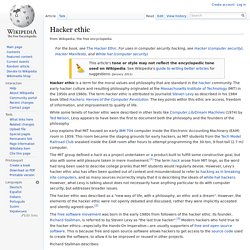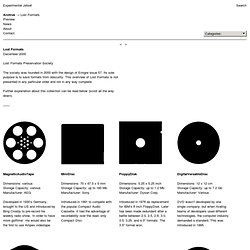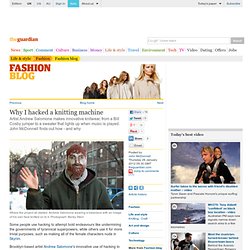

BBC One - imagine..., Summer 2013, Vivian Maier: Who Took Nanny's Pictures?, Vivian Maier - Nanny Photographer. Little Joe. Hauntologists mine the past for music's future. You may argue that pop culture has always drawn heavily on nostalgia, and you’d be right, but things have changed.

What was once a dim memory, a wobbly VHS tape, a slice of warped vinyl, or a bootleg DVD or CD trading hands amongst enthusiasts has become a towering digital midden so huge that it threatens to impede our view of the future. The growth of online media channels means that the near-entirety of our cultures’ pasts have been excavated and placed on display for anyone to watch, hear, or read in an instant. Hence, hauntology. At the heart of the musical micro-genre of hauntology is the sense of atemporality that underpins our present culture. Whether it’s musicians pastiching multiple vintage styles in a single track, the endless cycle of remakes and sequels in cinema, or historical genre mashups in pop literature, our future is looking increasingly like our past, which now looks like the future, which looks increasingly like the past, and so on. "Haunted, you said?
" A Conversation With My 12 Year Old Self: 20th Anniversary Edition. FutureMe.org: Write a Letter to the Future. Hacker ethic. While some tenets of hacker ethic were described in other texts like Computer Lib/Dream Machines (1974) by Ted Nelson, Levy appears to have been the first to document both the philosophy and the founders of the philosophy.

Levy explains that MIT housed an early IBM 704 computer inside the Electronic Accounting Machinery (EAM) room in 1959. This room became the staging grounds for early hackers, as MIT students from the Tech Model Railroad Club sneaked inside the EAM room after hours to attempt programming the 30-ton, 9-foot-tall (2.7 m) computer. The hacker ethic was described as a "new way of life, with a philosophy, an ethic and a dream". However, the elements of the hacker ethic were not openly debated and discussed; rather they were implicitly accepted and silently agreed upon.[2] The free software movement was born in the early 1980s from followers of the hacker ethic. Richard Stallman describes: The hacker ethics[edit] All information should be free Sharing[edit] See also[edit] [edit] Classic Commercials "Gameboy Camera" Game Boy Camera Commercial. Barbie camera. Experimentaljetset. MagneticAudioTape Dimensions: various Storage Capacity: various Manufacturer: AEG Developed in 1930’s Germany, brought to the US and introduced by Bing Crosby to pre-record his weekly radio show, ‘in order to have more golftime’.

He would also be the first to use Ampex videotape. MiniDisc Dimensions: 70 x 67.5 x 5 mm Storage Capacity: up to 160 Mb Manufacturer: Sony Introduced in 1991 to compete with the popular Compact Audio Cassette. FloppyDisk Dimensions: 5.25 x 5.25 inch Storage Capacity: up to 1.2 Mb Manufacturer: Dysan Corp. Introduced in 1976 as replacement for IBM’s 8 inch FloppyDisk. DigitalVersatileDisc Dimensions: 12 x 12 cm Storage Capacity: up to 7.2 GbManufacturer: Various DVD wasn’t developed by one single company, but when rivaling teams of developers used different technologies, the computer industry demanded a standard.
Jaz Dimensions: 3.7 x 3.5 inch Storage Capacity: up to 2 Gb Manufacturer: Iomega VideoHomeSystem Introduced in 1976. VideoEight PocketDisc DiamondDisc FourTrack SyJet. Why I hacked a knitting machine. Where the project all started: Andrew Salomone wearing a balaclava with an image of his own face knitted on to it.

Photograph: Becky Stern Some people use hacking to attempt bold endeavours like undermining the governments of tyrannical superpowers, while others use it for more trivial purposes, such as making all of the female characters nude in Skyrim. Brooklyn-based artist Andrew Salomone's innovative use of hacking to make custom knitwear will neither change the world nor impress gaming nerds, but it is going to make a lot of crafters very, very excited.
After getting the help of some tech-savvy friends who fiddled with a USB cable to connect a Brother KH-930e electronic knitting machine to a computer, he is now able to make the machine knit photorealistic copies of digital images, sort of in the same way a desktop printer reproduces an image. Andrewsalomone.com.